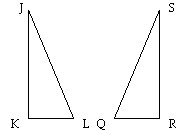Find two different Hamilton paths for the given graph.
A. A ? C ? H ? I ? G ? B ? D ? E ? F ; A ? C ? H ? I ? G ? B ? D ? F ? E
B. D ? E ? F ? I ? G ? B ? A ? C ? H ; H ? C ? B ? A ? G ? I ? F ? E ? D
C. The graph does not have two different Hamilton paths.
D. C ? A ? B ? D ? E ? C ? H ? I ? G ; A ? C ? H ? I ? G ? B ? D ? E ? F
Answer: A
You might also like to view...
Factor the polynomial completely.-2x2 - 10x - 12
A. prime B. -(2x + 3)(x + 4) C. -(2x + 4)(x + 3) D. -(2x - 4)(x - 3)
Provide an appropriate response.The two triangles shown below are congruent. The angles corresponding to ?J, ?K, and ?L (in order) are .
.
A. ?S, ?R, and ?Q B. ?Q, ?R, and ?S C. ?R, ?S, and ?Q D. ?S, ?Q, and ?R
Use the multiplication property of inequality to solve the inequality and graph the solution set on a number line. ? 3
? 3![]()
A. [18, ?)
![]()
B. (18, ?)
![]()
C. (-?, 18]
![]()
D. (-?, 18)
![]()
Expand, where i2 = -1. 4
4
A. -1 B. 1 C. 1 - i D. 1 + i